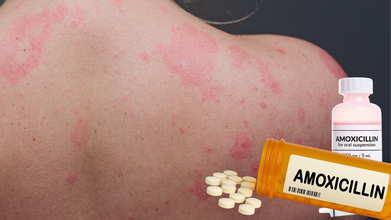- Health Conditions A-Z
- Health & Wellness
- Nutrition
- Fitness
- Health News
- Ayurveda
- Videos
- Medicine A-Z
- Parenting
Sugar-Free Slushies Pose Serious Health Risks to Young Children

(Credit-Canva)
We all enjoy a good slushie every now and then. While they do not add any great nutritional value to our meal, they are a delightful snack made with shredded ice and sugar. To make them more accessible to people who cannot or do not wish to have sugar, there are many sugar free options to pick from. However, a recent study has revealed that sugar-free slushies containing glycerol, which is a sugar alcohol used to maintain their icy texture, can cause severe health problems in young children. The study was published in the journal Archives of Disease in Childhood, it explains that having these sugar free slushies can lead to children having a condition called "glycerol intoxication syndrome". In this condition there is a rapid drop in blood sugar, reduced consciousness, and a buildup of acid in the blood.
Rapid Onset of Symptoms
Kids who drank slushies with glycerol got sick very quickly. Within an hour, they started showing serious symptoms. Their blood sugar would plummet, sometimes dangerously low. Many became confused or lost consciousness, and some even had seizures. Doctors studied 21 children who got sick from these drinks between 2018 and 2024. Most of these kids were very young, seven years old or younger. By the time they got to the hospital, many were in bad shape, either unconscious or barely awake. This quick reaction time makes it especially scary, as parents might not realize the slushy is the cause right away. It's important to recognize these signs fast.
Why is Glycerol Harmful?
According to WebMD Glycerol is a type of naturally occurring alcohol, and it's used in lots of food products. You might find it in protein bars, diet foods, and even sugar-free candies. In slushies, it plays a key role in keeping the drink icy. Usually, slushies use tons of sugar to stop them from freezing completely. But because people are trying to cut back on sugar, companies are using glycerol instead. This is especially true in places with "sugar taxes," where sugary drinks cost more. So, to make sugar-free versions, they add glycerol. This switch means more kids are being exposed to this ingredient, which can be harmful to them.
What Does Glycerol Damage Children's Health?
The study explains that little kids are more at risk from glycerol because their bodies are still growing and developing. Their tiny bodies and young metabolisms might not be able to handle glycerol as well as adults' bodies can. This means that even a small amount can cause a big problem. Also, the amount of glycerol in a slushy can vary, and it's hard to know exactly how much is safe. Factors like how fast they drink it, if they've eaten recently, or if they've been exercising can also make a difference. Even the standard size of a slushy drink can be too much for a small child. This makes it hard to give a safe dose.
Health authorities in the UK and Ireland have already started warning about glycerol in slushies. They suggest that kids under four shouldn't have them at all, and older kids should only have one at most. But doctors are worried that these warnings might not be enough. They point out that it's hard to know how much glycerol is actually in each drink, making it difficult to give safe advice. Parents are being told to be very careful and consider avoiding these drinks altogether for young children. In the US, glycerol is approved for use in food, but parents should still be aware of the potential risks. More research is needed to understand the full impact.
What To Do When Amoxicillin Gives You Rashes?

Credits: iStock
This year had been a year of flu, fiver, bacterial illness and more. One of the over the counter medicine that many people often buy, or is prescribed, especially for bacterial infections is Amoxicillin.
What Is Amoxicillin?
It is a widely prescribed antibiotic that is used to treat bacterial infections in children and adults. It is part of the penicillin class of medications and it inhibits the growth of bacteria and allows the immune system to efficiently eliminate the infection. It is commonly used to treat bacterial infections affecting the respiratory tract, urinary tract, and skin.
However, about 5 to 10 per cent of children prescribed this may develop skin rashes as a common side effect. A rash can develop in two forms: allergic and non-allergic. A rash from the drug Amoxicillin could last up to a week.
What Kind Of Rashes Are Caused By Amoxicillin?
A Maculopapular rash is a flat rash that occurs like red patches, raised bumps and spreads over the body.
Hives are itchy, raised red or skin-colored welts that can change shape and location.
Erythema Multiforme are more severe, featuring target-like lesions or bull's-eye shapes with central red spot, pale ring, and red outer ring.
Anaphylactic Reaction is a rare but severe allergic reaction that includes symptoms like difficulty in breathing, swelling of the face, lips, or tongue, hives and rapid drop in blood pressure.
Non-Allergic Amoxicillin Rash are flat, red spots that may be slightly raised, but not harmful. These usually appear o the 5th to 7th day after the start of amoxicillin and can appear on the chest, abdomen, back, face, arms, and legs. It may get worse before it starts to get better.
What Signs Should You Look Out For?
Warning signs include rashes within two hours of the first amoxicillin dose, difficulty breathing or swallowing, or very itchy hives.
The allergic reaction is caused by one's immune system reacting to that medication as if it were a foreign invader in the body.
More girls than boys develop these rashes, and in children this is even more common. In fact, the rash by amoxicillin was first noted in 1960s, in children who were being treated with ampicillin, recorded the Journal of Pediatrics.
What Can You Do If You Get Amoxicillin Rashes?
Among treatment, the first step should be to see your physician and immediately stop taking the medication. Drinking water and enough fluids can also help. Your doctor too would prescribe you medications and lotions to soothe your itching.
Hives can also be treated with the over the counter drug Benadryl. However, you must go see your doctor or GP, and not self medicate.
A doctor may treat the rash in various ways, including stopping the medication as the first line of defense. Then the doctor may give oral antihistamines (e.g., cetirizine) for the itch. Some doctors may use topical steroids to help with the itch and redness.
Before visiting your doctor, take photos of your rash, send it to your GP, as if it is contagious. Even after you start the treatment, stay in touch with your healthcare provider for any development.
36% Of Rabies Death Comes From India: This Is What You Should Do After A Dog Bite, Explains Doctor

Credits: iStock
The World Health Organization (WHO), notes that 36% of world's rabies deaths come from India, and a 2024 Lancet study notes that the country accounts for over one-third of global rabies deaths. When we spoke to Dr Aniket Mule, Consultant Internal Medicine at KIMS Hospital, Thane, he said that it is not just dog bites that lead to rabies, but it could happen from any rabies-susceptible animal. The first line of defense after you clear your wound immediately is to get the rabies vaccine. "Rabies vaccination is required for bites or scratches from any rabies-susceptible animal, including cats, monkeys, bats, foxes, and other wild mammals," he pointed out. As the country's apex court ruled and issued directives on stray dogs, focusing on public safety by ordering their removal, global health organizations, including WHO point out that this is not the right way to deal with rabies issue. Comprehensive methods including evidence=based strategies that center on mass dog vaccination is the key to the problem.
However, before this could be implemented, here's what you should know about dog bites and rabies.
What To Do After A Dog Bites Or Scratches You?
Dr Mule points out that even when there are minor scratches, without bleeding, you must get a rabies shot. "Rabies can be contracted through broken skin. Such exposures still require medical evaluation and, in most cases, rabies vaccination."
Read: In An 'Exceptionally Rare' Case, Man Dies Of Rabies After Kidney Transplant
What Should One Do Immediately After Being Bitten Or Scratched?
- Wash the wound immediately for at least 15 minutes with soap and running water
- Apply an antiseptic such as povidone-iodine
- Do not apply home remedies like turmeric, chili or oil
- Seek medical care promptly for rabies vaccination and possible immunoglobin
Dr Mule points out that the rabies vaccine should be started as soon as possible. "Ideally within 24 hours of a bite or scratch. However, even if there is a delay of days or weeks, vaccination should still be started immediately as rabies has a variable incubation period," he says.
After the bite, the immediate medical attention involves rabies post-exposure prophylaxis or PEP, and with a tetanus booster. Some rabies vaccines also use saline water as the diluent to reconstitute the freeze-dried powder before injection.
Read: Australia Issues Advisory Warning Travelers Of Counterfeit Rabies Vaccines Found In India
The temperature of the vaccine matters. "Rabies vaccines are temperature-sensitive and must be stored between 2°C and 8°C. Exposure to heat or freezing can reduce vaccine potency. Poor cold-chain maintenance is a known reason for vaccine failure in rare cases," points out the doctor.
Cases Of Rabies Coming Back After Vaccination Course Has Been Done
Dr Mule points out that in order to avoid such things happening, one must ensure immediate wound washing, timely vaccination, and correct use of Rabies Immunoglobulin or RIG. Rabies can come back if these following things occur:
- Delay in starting vaccination
- Failure to administer Rabies Immunoglobulin (RIG) in severe (Category III) exposures
- Improper wound cleaning
- Incorrect injection site (gluteal region)
- Poor vaccine storage (cold-chain failure)
Dr Mule points out that the vaccine should be given intramuscularly in the deltoid or upper arms for adults, as gluteal or buttock injections could lead to inadequate absorption and reduce effectiveness.
How Many Doses Should One Get?
- For someone not previously vaccinated, the current standard is 4 doses on days 0, 3, 7, and 14 (intramuscular schedule).
- In some government programs or intradermal schedules, 3–4 doses may be advised.
- Previously vaccinated individuals require only 2 booster doses (days 0 and 3).
The exact schedule depends on vaccination history and the protocol followed.
Five Essential Health Tests to Consider This Winter, According To A Doctor

Credits: iStock
Winter in India is often associated with sardio ke laddoo, but also with increasingly sedentary lifestyle, worsening air pollution, all of which leads to more time spending home than to going out, taking a stroll, working out and more. This is why as winter sets in, India also sees a quiet but consistent rise in non communicable diseases, or NCDs, conditions that now account for nearly two thirds of all deaths in the country. Heart disease, diabetes, thyroid disorders, fatty liver disease and arthritis continue to rise across age groups, driven by sedentary lifestyles, dietary excess and delayed diagnosis.
Winter can further aggravate these risks. Physical activity drops, calorie dense foods become routine, sunlight exposure reduces and metabolism changes. Studies and hospital data in India have repeatedly shown that heart attacks and strokes tend to spike during colder months. Blood vessels constrict, blood viscosity increases and cholesterol levels often rise. Blood sugar control also becomes more challenging, while joint pain and stiffness worsen for many.
Dr. Mayanka Lodha Seth, Chief Pathologist at Redcliffe Labs, says the problem is not seasonal food but seasonal neglect. “Traditional winter foods are not harmful on their own. The real risk comes from consuming them without understanding what is happening inside the body,” she explains. “Winter tends to mask symptoms while quietly worsening internal imbalances.”
With India already home to over 100 million people living with diabetes and a similar number estimated to be prediabetic, preventive testing becomes crucial. Doctors recommend five key tests that can offer a clearer picture of health before winter indulgence begins.
Blood Sugar Levels
Diabetes is one of the fastest growing NCDs in India, and a large proportion of cases remain undiagnosed. Winter diets high in sugar and fat can trigger frequent glucose spikes. Testing fasting blood sugar and HbA1c helps identify early risk and prevents long term complications affecting nerves, kidneys and the heart.
Lipid Profile
High cholesterol is a major contributor to cardiovascular disease, which remains India’s leading cause of death. Reduced activity in winter often pushes lipid levels higher. A lipid profile helps assess heart risk and guides dietary and lifestyle moderation before damage sets in.
Liver Function Test
Non alcoholic fatty liver disease is increasingly common in India, even among younger adults. Excess sugar and fat intake during winter can worsen liver fat accumulation. Early liver testing can flag reversible changes before they progress to chronic liver disease.
Thyroid Function Test
Thyroid disorders affect millions in India, especially women, and often go unnoticed. Symptoms like weight gain, fatigue and cold intolerance are frequently brushed off as winter sluggishness. A simple thyroid test helps distinguish seasonal lethargy from hormonal imbalance.
Vitamin D and Vitamin B12 Levels
Vitamin D deficiency is widespread due to limited sun exposure in winter, while Vitamin B12 deficiency remains common because of dietary patterns. Both deficiencies are linked to low immunity, muscle pain, bone weakness and worsening joint discomfort.
Dr. Seth adds, “Preventive diagnostic testing allows people to make informed choices. It helps them enjoy winter foods in moderation without unknowingly worsening an underlying condition.”
As NCD related healthcare costs continue to rise in India, early testing offers both health and financial protection. Winter comfort does not have to come at the cost of long term health. Staying informed may be the most effective preventive step this season.
© 2024 Bennett, Coleman & Company Limited

